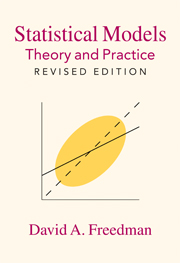Book contents
- Frontmatter
- Contents
- Foreword to the Revised Edition
- Preface
- 1 Observational Studies and Experiments
- 2 The Regression Line
- 3 Matrix Algebra
- 4 Multiple Regression
- 5 Multiple Regression: Special Topics
- 6 Path Models
- 7 Maximum Likelihood
- 8 The Bootstrap
- 9 Simultaneous Equations
- 10 Issues in Statistical Modeling
- References
- Answers to Exercises
- The Computer Labs
- Appendix: Sample MATLAB Code
- Reprints
- Index
1 - Observational Studies and Experiments
Published online by Cambridge University Press: 05 June 2012
- Frontmatter
- Contents
- Foreword to the Revised Edition
- Preface
- 1 Observational Studies and Experiments
- 2 The Regression Line
- 3 Matrix Algebra
- 4 Multiple Regression
- 5 Multiple Regression: Special Topics
- 6 Path Models
- 7 Maximum Likelihood
- 8 The Bootstrap
- 9 Simultaneous Equations
- 10 Issues in Statistical Modeling
- References
- Answers to Exercises
- The Computer Labs
- Appendix: Sample MATLAB Code
- Reprints
- Index
Summary
Introduction
This book is about regression models and variants like path models, simultaneous-equation models, logits and probits. Regression models can be used for different purposes:
(i) to summarize data,
(ii) to predict the future,
(iii) to predict the results of interventions.
The third—causal inference—is the most interesting and the most slippery. It will be our focus. For background, this section covers some basic principles of study design.
Causal inferences are made from observational studies, natural experiments, and randomized controlled experiments. When using observational (non-experimental) data to make causal inferences, the key problem is confounding. Sometimes this problem is handled by subdividing the study population (stratification, also called cross-tabulation), and sometimes by modeling. These strategies have various strengths and weaknesses, which need to be explored.
In medicine and social science, causal inferences are most solid when based on randomized controlled experiments, where investigators assign subjects at random—by the toss of a coin—to a treatment group or to a control group. Up to random error, the coin balances the two groups with respect to all relevant factors other than treatment. Differences between the treatment group and the control group are therefore due to treatment. That is why causation is relatively easy to infer from experimental data. However, experiments tend to be expensive, and may be impossible for ethical or practical reasons. Then statisticians turn to observational studies.
- Type
- Chapter
- Information
- Statistical ModelsTheory and Practice, pp. 1 - 17Publisher: Cambridge University PressPrint publication year: 2009



